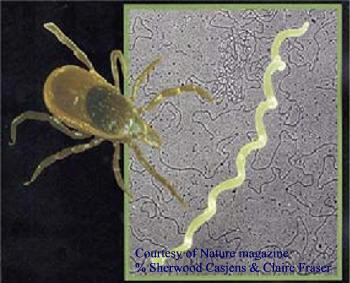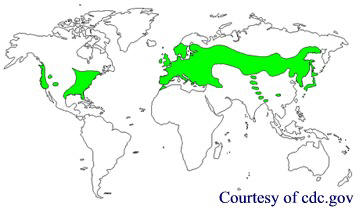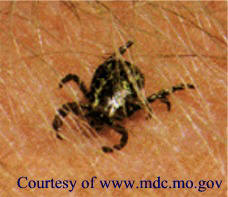|
Borrelia burgdorferi
is an endoparasitic species and therefore its main habitat and
nutrition is in host tissue. An endoparasite is a parasite
that lives within the cells and tissues of its host (Singleton,
P., & Sainsbury, D., 2006).
The most prominent organism in
which B. burgdorferi infects is the Ixoidid tick species,
which are ticks that have a hard outer covering . Ixoidid
ticks are most commonly found in the northern hemisphere and in
wooded areas and therefore, the species B. burgdorferi
is most apparent in these areas as well. Ixoidid ticks are
exoparasites and generally attach to intermediate sized mammals such
as deer, rabbits, mice and also some species of birds. Ticks
also accidentally attach to humans while waiting for a deer to
attach to, making humans secondary hosts of Ixoidid ticks (O'Connel,
S., 2005).
Ixodes tick and Borrelia
 burgdorferi burgdorferi
B. burgdorferi
species reside in the midgut of Ixoidid ticks. While the
tick slowly feeds on blood meal, B. burgdorferi
multiply and disperse within the tick through the hemolymph.
However, B. burgdorferi
bacteria not only reside in the tissues of Ixoidid ticks but change
habitats when infecting one of their secondary hosts - small- to
medium-sized mammals including humans. This bacteria species
is transmitted to other hosts through the saliva of a tick.
B. burgdorferi then can spread through the bloodstream and
lymphatic system to a variety of tissues and has the potential to
infect the circulatory, muscle, skeletal, and nervous systems (Schnarr,
S., Franz, J., Krause, A., & Zeidler, H., 2006). The actual
life cycle of B. burgdorferi
is discussed in the "Reproduction"
section of this web page.
In order to get
into a mammalian host, B. burgdorferi is dependent upon
the Ixoidid tick population. Therefore, part of the
ecological niche of this bacteria species is the presence of Ixoidid
ticks (specific tick species fluctuate depending upon region).
Once B. burgdorferi infects a mammalian host, it remains
within that host for life; however some mammals seem to be
unaffected by this endoparasite (see "Other
Facts" section of this web page). Mammalian hosts are considered
"animal reservoirs" for B. burgdorferi (Coburn, J. &
Kalish, R., 2000).
A large population of these mammals need to be infected so
that in turn, ticks will feed on them, become infected, and the
cycle of B. burgdorferi can continue. Therefore, some
ecological niches of B. burgdorferi include, moderate
temperatures generally in forested areas, the midgut of Ioxidid
ticks, and intermediate sized mammals that live in close
proximity. Additional niches can be found in the "Adaptation"
section of this web page.

This is the distribution of the Ixodes tick
species who transmit the
Borrelia burgdorferi
species which in turn causes Lyme Disease.
More specifically, the hosts that ticks infect include:
The white-footed mouse is the primary host of an Ixoidid tick
* Mice, (generally white-footed mice) rabbits,
quail, songbirds, foxes, squirrels, and other rodents which all act
as primary hosts for ticks
The white-tailed deer is the
intentional secondary host of an Ioxidid tick. Humans are an incidental host of Ioxidid ti cks. cks.
* Ultimately, ticks want to attach to white-tailed
deer as their secondary hosts; however, often ticks incidentally
attach to humans passing by.
The following is a lifecycle of a tick that
exhibits the variety of hosts that the ticks attaches to at various
points in its growth and development. |